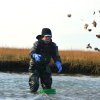Politics has become the art of the impossible: keeping people happy
People enjoy taking potshots at politicians, but a recent story reminded me just how difficult it is to govern in modern-day America.
Last year, Delaware’s General Assembly passed a bill allowing aquaculture - the farming of oysters and clams - in the Inland Bays, which include the Rehoboth, Indian River and Little Assawoman bays and the Delaware portion of the Big Assawoman Bay.
(Yes, newcomers, we have both Big and Little Assawoman bays in Sussex. Do not be offended. According to the generally accepted story, Assawoman is a corruption of an Indian word, and the names have nothing to do with the size of what is today often called booty. However, that is a dull story, and I think we should come up with something more entertaining and run with it.)
The bill passed the Senate 19-0, the House 41-0. On Aug. 28, 2013, Gov. Jack Markell signed it into law.
It looked like that rare thing, a win-win-win situation: a new industry to provide jobs; more fresh seafood to sell in local restaurants; plus the hardworking little bivalves would help filter and clean the bays as they fattened themselves up for our consumption.
It was a legislative hat trick. A good deal for everybody, except maybe the clams and oysters, who can’t vote, with or without photo ID.
Also, as the legislation itself noted, Delaware is the only state on the East Coast without an aquaculture industry.
And since there had been many public meetings and newspaper articles before the bill was introduced, and since this law had passed both chambers of the General Assembly unanimously, then everybody must be happy - right?
Wrong!
One business owner said oyster farming could harm sailboat rentals because the leased areas would deny boaters sufficient room to navigate. Some Fenwick-area residents have said their views will be compromised. Despite all the advance notice, they seemed surprised that aquaculture was coming to the Inland Bays.
It’s hard to believe the business concerns couldn’t be addressed. By law, aquaculture leases cannot exceed 5 percent of Rehoboth and Indian River bays and 10 percent of the Little Assawoman Bay. By law, the regulations must keep navigation open.
It’s not like this industry is going to explode. It grew slowly in other states, and it will grow slowly here. According to the Chesapeake Bay Journal, it took 30 years for the Virginia clam farms to grow into a $30 million business, and it’s expected the Virginia oyster industry will take just as long.
Some concerns seem more emotional than factual. One woman was quoted in The News Journal saying the aquaculture would “only degrade this precious resource through visual and environmental pollution.”
First, visual pollution is in the eye of the beholder. Many people are upset by things like cement mixers rolling by, big tractors slowing up traffic or the temporary presence of construction equipment - in other words, evidence of people making a living.
Some people retire here and seem to forget that it’s more than just a community for older people with nice pensions. Or a weekend getaway. It’s a real community of all ages and income levels.
True, I don’t own a property on the Delaware Inland Bays, but over the years I’ve watched quite a few watermen plying their trade on the Chesapeake, making repeated rounds of their trot lines - often marked by plastic milk or detergent containers - checking to see if they’ve enticed any crabs into their traps.
I’ve never considered the watermen or their equipment visual pollution; quite the opposite. I enjoy watching them and I enjoy the fruit of their labors: crabs, crab cakes, stuffed rockfish, Seafood Norfolk, etc.
As for “environmental pollution,” that doesn’t make any sense. An adult oyster, according to the Chesapeake Bay Foundation, can filter up to 50 gallons of water a day.
Before their stocks were depleted by overfishing, the bay’s oysters could filter the Chesapeake’s 19 trillion gallons every few days. Absolutely extraordinary. That filtering process is one of the chief reasons Maryland has worked so hard to restore the bay’s oyster population. The oysters would help improve the environment of the Inland Bays.
And speaking of visual pollution - see what a good segue this is? - one of my pet peeves has been the great number of abandoned buildings that dot the Sussex County landscape. At best eyesores, these falling-down buildings can also be dangerous.
How many are there? Who knows?
But a recent project in Detroit might provide a way to track them. Using a “blexting” app, people, including many volunteers, were able to document the condition of the city’s 372,000 properties. Nearly 85,000 were judged to be in need of intervention.
Actually doing something is another matter, but at least now Detroit officials have a better understanding of the problem and where work needs to begin.
Perhaps blexting - the word combines “blight” and “texting” - could work here. People who consider themselves too old for sexting might be happy to experiment with blexting.




















































